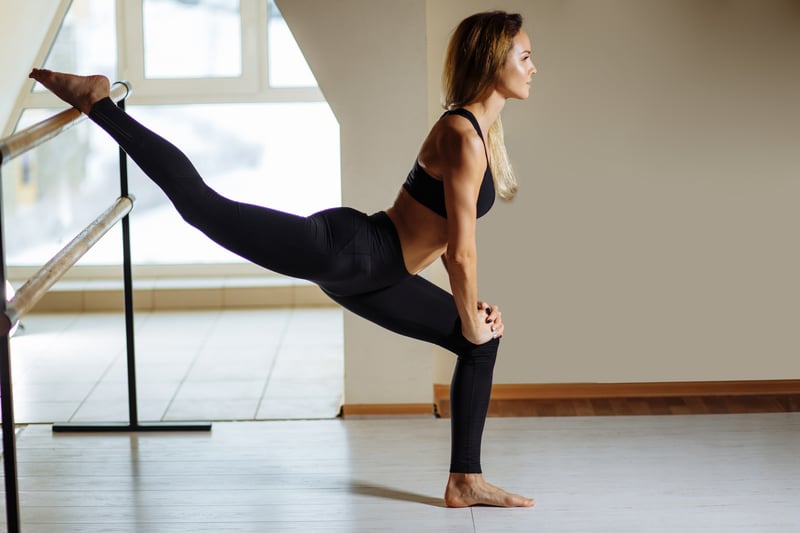What is Barre Class + 6 Powerful Benefits of Barre Exercises

Have you heard of barre exercises? Are you ready to hit the barre? No, we’re not talking about bar games like beer pong and darts. We’re talking about a type of exercise done in a classroom setting and touted as being able to help you build long, lean muscles like a dancer’s. And we will show you other health benefits of barre exercises.
What is Barre?
Barre is a combination of Pilates, ballet, and yoga, and it entails strengthening, stretching, and balancing exercises. While the actual logistics of the class may vary from location to location and teacher to teacher, the overall theme is the same and focuses on strengthening and defining your arms, legs, and especially the core through proper alignment and the strategic use of isometric contractions (maintaining muscular tension such as in a squat or plie position) along with pulses (moving the body short distances of less than an inch up to a couple of inches, again keeping the muscle under tension), and full body movements.
How Did the Barre Trend Start?
Barre fitness classes were originally thought up by a German ballet dancer, Lotte Berk, who had injured her back and wanted a good way to heal. She thought combining her ballet training along with her rehab moves would be beneficial for others; thus, she ended up opening a studio to teach this new exercise technique. In 1971, Lydia Bach, one of Berk’s original students, brought barre exercises to the States, and it has since blossomed into the “it” workout among the hip and fit.
You can now find barre exercise classes almost anywhere, including some of the following franchise locations: Pure Barre, Barre Concept, Bar Method, Core Fusion, Balletone, and many more. Check local listings as classes may also be found at other fitness facilities.
What Equipment Is Needed for Barre Exercise?
To perform a barre workout, you’ll need, drumroll, please… a ballet barre (or sturdy chair). That’s it to experience the benefits of barre exercises. Granted, some barre studios have expanded to some light weights, resistance bands, and exercise balls, but technically speaking, all that’s really needed is the ballet barre. And some classes focus on floor exercises that don’t even require a ballet barre and may instead use a mat in the center of the room (away from the barre).
As for clothing, just wear something comfy, such as leggings or yoga pants and a tank top, like what you might wear to a yoga class. And, you can either workout barefoot or throw on some socks (sticky socks or toe socks are often recommended), ballet slippers, or special dance shoes with some grip on the bottom.
What Are the Benefits of Barre Exercises?
At first glance, it may seem like this is not a true workout—it looks like it’s maybe just more of a stretch. But, you’d be surprised at how challenging and effective a workout barre can be and some of the amazing benefits of barre exercises. This type of exercise focuses on your core but you’ll feel every muscle in your body working (including ones you didn’t know you had). Trust me, the workouts are a lot tougher than they look.
Here are some of the types of movements you can expect:
Isometric contractions—these exercises involve contracting muscles against each other (or against a fixed object). These small movements involve tightening the muscles and using slow-twitch muscle fibers. They also help to involve muscles you may not normally use when doing a more mainstream workout. In addition to the isometric contractions, you’ll also make small movements—just an inch or two. You may think you need to go big, but these exercises are effective because they are so small. As you hold the poses, you’ll likely notice that your muscles start to quiver and shake as they fatigue, showing you just how hard you’re working.
Mind and body connection—as with yoga, when you do barre exercises, you strengthen your mind and body connection. Over time, you’ll learn how to contract various muscles in your body and to focus on them as you hold the contraction. The more you practice, the deeper the connection you’ll be able to forge with yourself.
Flexibility—yes, you will definitely get more flexible when practicing barre exercises. While doing the movements correctly will require flexibility, it’s something you can also develop over time with practice. Gaining flexibility is a huge positive that will benefit you across the board in every area of your life.
Strength—believe it or not, you can get stronger with these simple concentrated exercises. Isometrics help you isolate small, and large, muscle groups and work them separately. Proponents of barre classes swear they gain strength and a lot of definition from these exercises.
Posture—typically, when you increase your flexibility, and strengthen your muscles, your posture almost naturally improves. It’s all about positioning and balance. With the focus on learning the proper way to align your body, so your power comes from your core and legs and not from your knees or ankles, this is particularly true with barre classes. This is one of the benefits most people discover right away as they learn what really good posture looks and feels like with your hips over your knees and ankles, shoulders over hips, and head over shoulders to keep your head uplifted, spine straight, shoulders back, core tight, and hips tucked under.
Conditioning—yes, you can improve your conditioning. Have you ever gotten exhausted from doing a series of planks? Well, along these same lines, isometric exercises can also help you build stamina and endurance when practiced regularly over time.
Plus, other benefits of barre exercises include improved muscle definition, increased weight loss, increased flexibility, and even reduced stress and is great for just about every fitness level.
Is There a Negative Side to Barre Exercises?
Now that you’ve learned what barre exercise is and some of the many benefits to doing these workouts, you may be wondering what’s the downside? Well, depending on the class, you may want to add some aerobic type conditioning and/or resistance training to your workout routine just to round things out (though many classes do include both), yet the main downside to barre exercise is the expense. Classes are typically boutique style and can set you back up to $200 a month. Your gym or fitness center may offer barre classes for less, or you can find affordable streaming on-demand classes online. Pure Barre offers barre-inspired classes as do Daily Burn and others, so you can find a class to try in the privacy of your own home if you choose.
What Is a Barre Exercise Class Like?
What can you expect from a barre exercise class? Well, the good news is you do not have to be a prima ballerina. In fact, this is the perfect type of exercise for beginners as well as more advanced fitness enthusiasts looking for a change of pace or to improve posture to help prevent or aggravate injuries.
You’ll be targeting the entire body, including the arms, legs, glutes, and of course, your core. Balance plays a big part (and one of the biggest benefits of barre exercises) in the overall barre technique, and you’ll use isometric exercises to work out all your muscles.
Typically, you’ll warm up your entire body, with a particular focus on upper body musculature. This can include anything from bodyweight exercise like pushups to planks to the use of light weights and more. Then, you’ll usually move to lower body exercises including traditional ballet moves like plies and releves and incorporate the barre (or a sturdy chair if you’re at home), as well as your bodyweight, and engage in small isometric-like movements, often referred to as pulses. You’ll hold these movements for a specified period of time, following your instructor’s lead. This makes up the bulk of the class.
At the end of the class, you’ll typically finish off with stretching and flexibility exercises to help you cool down. After you’ve gone to a few classes and learned the various movements, you’ll likely experience some benefits of barre exercises like standing up straighter and taller, feeling a bit longer and leaner.
So, who’s ready to hit the barre?







